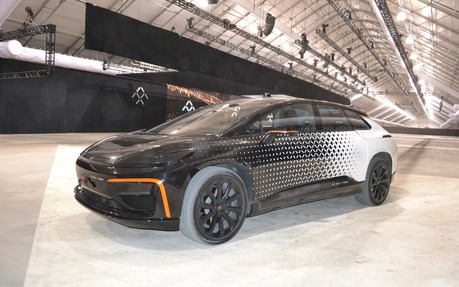Exclusive Test Drive of the Faraday Future FF 91: Watch your back, Tesla!
Last year, automaker Faraday Future presented the FFZERO1 concept car at the Consumer Electronics Show. They claimed an all-electric production version would be forthcoming within a year. With so many new faces in the automobile world, we were naturally sceptical.
A year later, it looks like Faraday Future delivered on its promise, having just unveiled an initial production model, the 2018 FF 91. We got the chance to see this newbie—a direct rival to Tesla—and we even got to drive it!
Futuristic lines and cabin
Featuring a Mitsubishi-like logo, Faraday Future is a California-based firm backed primarily by Chinese investors. From a styling standpoint, the FF 91 (that’s “nine-one” FYI) combines SUV and pickup lines and is presented with an ultramodern design—so much so that you’d think it was a concept vehicle. It features reverse-opening rear doors for improved access to the spacious cabin. Sensors make sure the doors don’t hit anything or anyone.
Inside, the passenger compartment is absolutely spectacular. Again, it looks like a concept car taken straight from the future. The round-edged dashboard houses three large screens that display practically all onboard systems. There are no rearview mirrors either, just cameras that give you a full view of the vehicle’s sides and rear. No more blind spots! Since the FF 91 is so big, the interior is spacious and welcoming, as you’d find in a minivan.

0-96 km/h in 2.39 seconds, the fastest of all production electric vehicles!
We discovered the new king of electric cars by driving it in a massive hangar just outside Las Vegas. The two vehicles there were prototypes with unfinished interiors. The idea was to get us acquainted with the model’s dynamic capabilities—and it was an experience we won’t soon forget!
Even though it looks like a minivan, the FF 91 has all the qualities of a supercar. Three electric motors—one in front and two in back—deliver a total of 783 kW (1050 horsepower). When the driver approached the acceleration line, the FF 91 jumped into action without making a sound, silently pinning us to our seats. Some passengers had forgotten to lean on the headrests for support and suddenly we felt like we were on a rollercoaster, that’s how brutal the acceleration was. With a 0-96 km/h (0-60 mph) time of 2.39 seconds, the FF 91 is the fastest production EV in the world, overtaking the Tesla P100D. It even beat the Ferrari 488 in a sprint!
Four-wheel steering
The other aspect that sets this vehicle apart is its maneuverability: its four-wheel drive system includes torque vectoring and four-wheel directional steering to maximize cornering performance. Avoiding obstacles while moving at high speeds is child’s play because the system prevents excessive weight transfer to the rear (which can be a problem for larger vehicles). Not only does this improve cornering performance, it also makes the ride more comfortable for the people on board.
The FF 91 is built on Variable Platform Architecture that could be used for several other models. The software that controls the batteries, drivetrain and doors was developed by Micrium, a Quebec-based firm. The FF 91 promises 378 miles (700 km) of range, which is more than any other EV. The Level 2 domestic charging station included with purchase can charge the battery to 50% in 4.5 hours.
Naturally, the FF 91 will come with a plethora of passenger safety technology, as well as Level 4 autonomous driving. Valet mode allows the vehicle to park itself after dropping you off at the door—and it will come back and pick you up later. At launch, this feature can only be activated on private land for legal reasons, as driverless cars still aren’t permitted on the road. A facial recognition camera recognizes the approaching driver, opens the door and personalizes the cabin to their preferences.

Not cheap
Interested? Buyers can reserve a unit by leaving a $5,000 refundable deposit. The first 300 customers will have the privileged option of spending a little more for an Alliance Edition unit, part of a more exclusive series. According to the manufacturer, some 64,000 deposits have been received since the vehicle was presented. However, with an estimated price tag of $150,000, we’re wondering how Faraday Future will generate enough sales to finance the development of other models.
